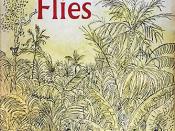In Lord of the Flies Golding uses symbolism to tell us that environment, actual of perceived, controls behavior. The white conch is symbolic of government structure and power. The Lord of the Flies represents the evil in human nature and the characters reveal the way they either are controlled by or control the beast. Golding states that his theme is "Society must depend on the ethical nature of the individual and not on any political system however apparently logical or respectable"(204). The environment of the island on which the characters are morooned reflects symbolically the ethical nature of the individuals since there are no adults or governmental controls. For most of the boys this results in a progression towards impulsive behavior and a deterioration in moral responsibility from a civilized organized society to a savage primitive mob. In the beginning of the novel, the system of government appears to be working.
The boys are working together to make life on the island better, and they have a logical plan of action. '"We'll have rules...lots of rules!"' Ralph exclaims (33). From the very beginning, the boys set up a hierarchical class structure and everyone has a task to perform. The boys all wear uniforms and each is supposed to contribute to the welfare of the whole. This is in sharp contrast to the end of the novel when the boys are naked with war paint and spears hunting down a human being to kill.
The boys are controlled by their environment instead of by the organizing system of the conch. Even Ralph succumbs to the environment by taking off all his clothes and swimming naked because there are no adults, and thus no rules on the island. "He undid the snake-clasp of his belt, lugged off his shorts and pants, and...


